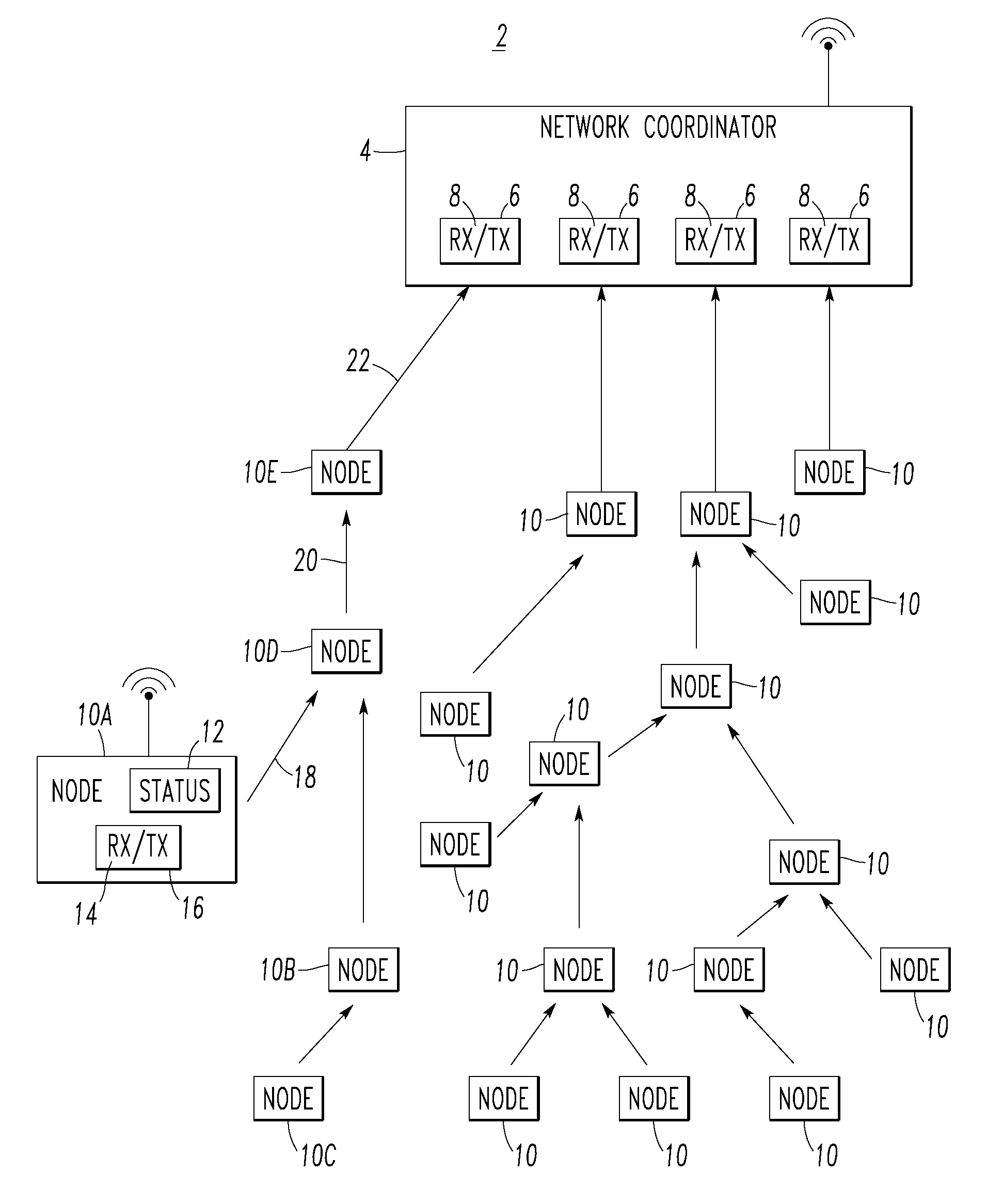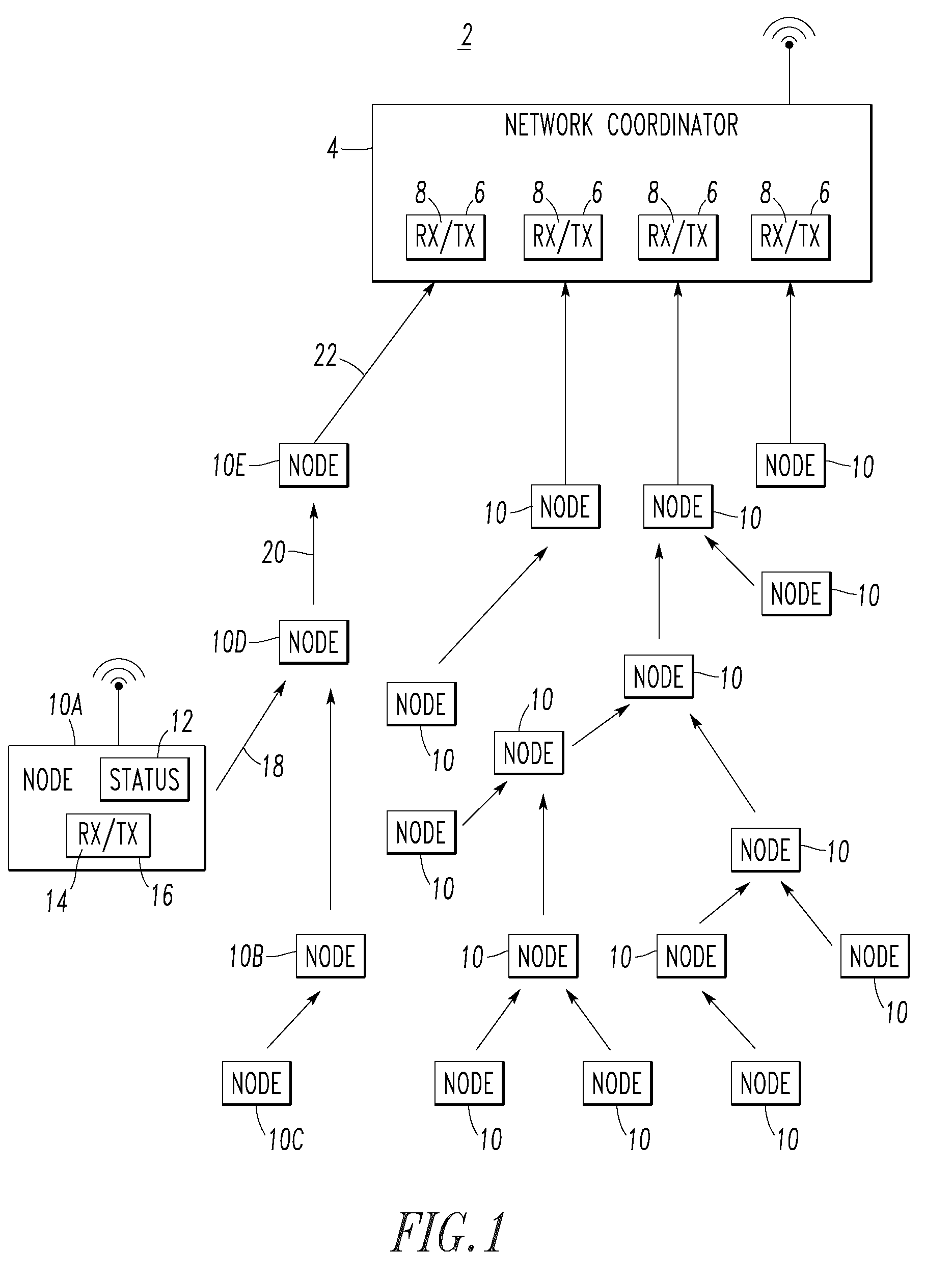Wireless communication network and data aggregation method for the same
a wireless communication network and data aggregation technology, applied in the field of wireless communication networks, can solve the problems of affecting the status of the communication, affecting the communication, and affecting the communication, and achieve the effect of fast status information collection
- Summary
- Abstract
- Description
- Claims
- Application Information
AI Technical Summary
Benefits of technology
Problems solved by technology
Method used
Image
Examples
example 1
[0052]In order to minimize collisions, there are multiple channels 8,14 (e.g., without limitation, 2; 4; 8; 16; any suitable count of channels) for the wireless sensor network 2 and one or more radio transceivers 16 for each of the nodes 10. The operation time of the wireless sensor network 2 is divided into relatively short time slots 26 with identical durations. For each time slot 26, a subset (one or more) of the nodes 10 is scheduled to forward the status information 12 of their own and their descendants (e.g., their children; their grandchildren; their great-grandchildren) to their corresponding parent nodes, in a fashion that avoids collisions for efficiency.
example 2
[0053]The example wireless sensor network 2 is based upon the following. First, an address tree topology (FIGS. 7A, 8 or 9) is built in order that the NC 4 is the root of the tree and all the other nodes 10 are descendants of the NC 4. The tree is preferably built in a manner in order that the packet delivery success rate is very close to about 100%. Second, transmissions from the different wireless channels 8,14 are assumed to not interfere with each other, while simultaneous transmissions may interfere with each other if they are in the same wireless channel. Third, the nodes 10 are preferably mains-powered in order that a reasonable synchronization update rate (e.g., without limitation, about one packet per minute) can be supported. Finally, the count of the nodes 10 may be, for example and without limitation, in the range of about 500 to about 1000.
example 3
[0054]The example constraints for this scheduling are as follows. First, a node 10 (e.g., 10D) cannot send the status information 12 to its parent node (e.g., 10E) until it gathers all the status information 12 from its children (e.g., 10A and 10B). This is a Time slot Allocation Constraint (TAC): a node's time slot (TS) 26 number must be greater than its parent's TS 26 number. Before a parent node (e.g., 10D) can report to its own parent node (e.g., 10E), it needs to wait until its child nodes (e.g., 10A and 10B) report to it.
[0055]Second, no two nodes 10 can send information simultaneously in the same communication channel 14.
[0056]Third, there is an upper limit of the number of communication channels 8,14 (Channel Allocation Constraint (CAC)), the number of radio transceivers 6,16 for the whole wireless sensor network 2 (Radio Allocation Constraint (RAC)), and the number of radio transceivers 16 for each individual node 10 (Node Radio Allocation Constraint (NRAC)). The number of ...
PUM
 Login to View More
Login to View More Abstract
Description
Claims
Application Information
 Login to View More
Login to View More - R&D
- Intellectual Property
- Life Sciences
- Materials
- Tech Scout
- Unparalleled Data Quality
- Higher Quality Content
- 60% Fewer Hallucinations
Browse by: Latest US Patents, China's latest patents, Technical Efficacy Thesaurus, Application Domain, Technology Topic, Popular Technical Reports.
© 2025 PatSnap. All rights reserved.Legal|Privacy policy|Modern Slavery Act Transparency Statement|Sitemap|About US| Contact US: help@patsnap.com



